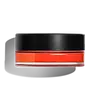What's inside
What's inside
 Key Ingredients
Key Ingredients

 Benefits
Benefits

 Concerns
Concerns

 Ingredients Side-by-side
Ingredients Side-by-side

Ricinus Communis Seed Oil
MaskingCera Alba
EmollientCastor Isostearate Succinate
Skin ConditioningCaprylic/Capric Triglyceride
MaskingDiisostearyl Malate
EmollientCaprylic/Capric/Myristic/Stearic Triglyceride
EmollientCoconut Alkanes
EmollientMica
Cosmetic ColorantHydrogenated Castor Oil
EmollientBrassica Campestris/Aleurites Fordi Oil Copolymer
Skin ConditioningSimmondsia Chinensis Seed Oil
EmollientArgania Spinosa Kernel Oil
EmollientZingiber Officinale Root Oil
MaskingCitrus Grandis Peel Oil
MaskingCitrus Aurantium Dulcis Peel Oil
MaskingHippophae Rhamnoides Fruit Oil
Skin ProtectingRosmarinus Officinalis Leaf Oil
MaskingPelargonium Graveolens Oil
MaskingCoco-Caprylate/Caprate
EmollientPhenoxyethanol
PreservativeTocopheryl Acetate
AntioxidantSilica
AbrasiveTocopherol
AntioxidantSynthetic Fluorphlogopite
Iron Oxides
CI 77163
Cosmetic ColorantCI 77891
Cosmetic ColorantCI 45410
Cosmetic ColorantRicinus Communis Seed Oil, Cera Alba, Castor Isostearate Succinate, Caprylic/Capric Triglyceride, Diisostearyl Malate, Caprylic/Capric/Myristic/Stearic Triglyceride, Coconut Alkanes, Mica, Hydrogenated Castor Oil, Brassica Campestris/Aleurites Fordi Oil Copolymer, Simmondsia Chinensis Seed Oil, Argania Spinosa Kernel Oil, Zingiber Officinale Root Oil, Citrus Grandis Peel Oil, Citrus Aurantium Dulcis Peel Oil, Hippophae Rhamnoides Fruit Oil, Rosmarinus Officinalis Leaf Oil, Pelargonium Graveolens Oil, Coco-Caprylate/Caprate, Phenoxyethanol, Tocopheryl Acetate, Silica, Tocopherol, Synthetic Fluorphlogopite, Iron Oxides, CI 77163, CI 77891, CI 45410
Caprylic/Capric Triglyceride
MaskingOleic/Linoleic/Linolenic Polyglycerides
EmollientPolyglyceryl-2 Isostearate/Dimer Dilinoleate Copolymer
EmollientDiisostearyl Malate
EmollientCastor Oil/Ipdi Copolymer
Dextrin Isostearate
Skin ConditioningC8-12 Acid Triglyceride
Skin ConditioningEuphorbia Cerifera Wax
Camellia Oleifera Seed Oil
Skin ConditioningGlyceryl Behenate/Eicosadioate
EmollientSilica
AbrasiveCamellia Japonica Seed Oil
EmollientIsostearic Acid
CleansingTocopherol
AntioxidantParfum
MaskingAlumina
AbrasiveTin Oxide
AbrasiveCI 12085
Cosmetic ColorantCI 15850
Cosmetic ColorantCI 15985
Cosmetic ColorantCI 17200
Cosmetic ColorantCI 19140
Cosmetic ColorantCI 42090
Cosmetic ColorantCI 45380
Cosmetic ColorantCI 45410
Cosmetic ColorantCI 73360
Cosmetic ColorantCI 77163
Cosmetic ColorantCI 77491
Cosmetic ColorantCI 77492
Cosmetic ColorantCI 77499
Cosmetic ColorantCI 77742
Cosmetic ColorantCI 77891
Cosmetic ColorantMica
Cosmetic ColorantCaprylic/Capric Triglyceride, Oleic/Linoleic/Linolenic Polyglycerides, Polyglyceryl-2 Isostearate/Dimer Dilinoleate Copolymer, Diisostearyl Malate, Castor Oil/Ipdi Copolymer, Dextrin Isostearate, C8-12 Acid Triglyceride, Euphorbia Cerifera Wax, Camellia Oleifera Seed Oil, Glyceryl Behenate/Eicosadioate, Silica, Camellia Japonica Seed Oil, Isostearic Acid, Tocopherol, Parfum, Alumina, Tin Oxide, CI 12085, CI 15850, CI 15985, CI 17200, CI 19140, CI 42090, CI 45380, CI 45410, CI 73360, CI 77163, CI 77491, CI 77492, CI 77499, CI 77742, CI 77891, Mica
 Reviews
Reviews

Ingredients Explained
These ingredients are found in both products.
Ingredients higher up in an ingredient list are typically present in a larger amount.
This ingredient is an emollient, solvent, and texture enhancer. It is considered a skin-softener by helping the skin prevent moisture loss.
It helps thicken a product's formula and makes it easier to spread by dissolving clumping compounds.
Caprylic Triglyceride is made by combining glycerin with coconut oil, forming a clear liquid.
While there is an assumption Caprylic Triglyceride can clog pores due to it being derived from coconut oil, there is no research supporting this.
Learn more about Caprylic/Capric TriglycerideCI 45410 is a synthetic red-pigment and dye.
It often goes by both Red 28 or Red 27; manufacturers label both ingredients as CI 45410.
This dye is commonly found in makeup because it imparts a vivid color. Some types of this dye change color based on pH level and interaction with moisture:
Your skin has a natural pH of around 4.5 - 5.5.
According to the FDA, CI 45410 is not permitted for use in eye products.
Red 27 is a flourescein dye and commonly used as a fluorescent tracer in medicine.
Learn more about CI 45410This synthetic powder is used to add a pearly/white color in cosmetics.
Ci 77891 is a white pigment from Titanium dioxide. It is naturally found in minerals such as rutile and ilmenite.
It's main function is to add a white color to cosmetics. It can also be mixed with other colors to create different shades.
Ci 77891 is commonly found in sunscreens due to its ability to block UV rays.
Learn more about CI 77891Diisostearyl Malate is an emollient and most often used in lip products. It comes from isostearyl alcohol, a fatty acid, and malic acid, an AHA.
As an emollient, Diisostearyl Malate helps create a thin film on your skin to trap moisture in. This helps keep your skin soft and smooth.
Mica is a naturally occurring mineral used to add shimmer and color in cosmetics. It can also help improve the texture of a product or give it an opaque, white/silver color.
Serecite is the name for very fine but ragged grains of mica.
This ingredient is often coated with metal oxides like titanium dioxide. Trace amounts of heavy metals may be found in mica, but these metals are not harmful in our personal products.
Mica has been used since prehistoric times throughout the world. Ancient Egyptian, Indian, Greek, Roman, Aztec, and Chinese civilizations have used mica.
Learn more about MicaSilica, also known as silicon dioxide, is a naturally occurring mineral. It is used as a fine, spherical, and porous powder in cosmetics.
Though it has exfoliant properties, the function of silica varies depending on the product.
The unique structure of silica enhances the spreadability and adds smoothness, making it a great texture enhancer.
It is also used as an active carrier, emulsifier, and mattifier due to its ability to absorb excess oil.
In some products, tiny microneedles called spicules are made from silica or hydrolyzed sponge. When you rub them in, they lightly polish away dead skin layers and enhance the penetration of active ingredients.
Learn more about SilicaTocopherol (also known as Vitamin E) is a common antioxidant used to help protect the skin from free-radicals and strengthen the skin barrier. It's also fat soluble - this means our skin is great at absorbing it.
Vitamin E also helps keep your natural skin lipids healthy. Your lipid skin barrier naturally consists of lipids, ceramides, and fatty acids. Vitamin E offers extra protection for your skin’s lipid barrier, keeping your skin healthy and nourished.
Another benefit is a bit of UV protection. Vitamin E helps reduce the damage caused by UVB rays. (It should not replace your sunscreen). Combining it with Vitamin C can decrease sunburned cells and hyperpigmentation after UV exposure.
You might have noticed Vitamin E + C often paired together. This is because it is great at stabilizing Vitamin C. Using the two together helps increase the effectiveness of both ingredients.
There are often claims that Vitamin E can reduce/prevent scarring, but these claims haven't been confirmed by scientific research.
Learn more about Tocopherol